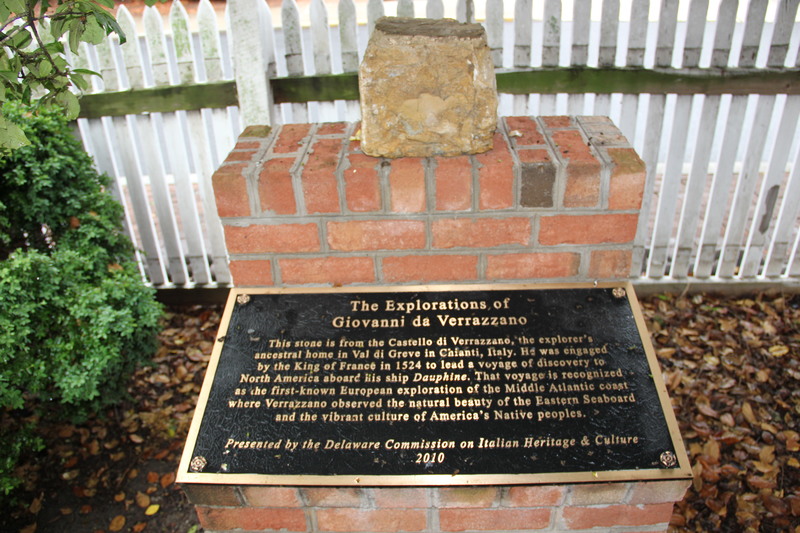Everybody wants to be first. It might have been the Dutch who first laid claim to establishing a settlement, in 1631, in what would eventually become Lewes, but less than a year ago, the Italians also moved themselves into the local historical scene. Under the auspices of the Delaware Commission on Italian Heritage and Culture, Lewes Historical Society last September placed a monument with a bronze plaque behind the Cannonball House. Above the plaque, cemented into the top of the monument, is a piece of carved Italian stone. That stone, says the plaque, is from the ancient castle in Italy that was once home to the famed explorer Giovanni di Verrazzano.
According to the plaque's information, the connection to the Delaware coast is that Verrazzano was the first European to explore the Mid-Atlantic coast, in about 1524. There's no official record that Verrazzano came ashore in what would eventually become Delaware, but history about the explorer states that he and his crew did have contact in the region with Native Americans.
The Lewes marker followed placement of a similar marker in Rehoboth Beach, at Olive Avenue and the Boardwalk, in 2008. That monument includes three stones from the Verrazzano Castle. (There has always been a friendly rivalry between Lewes and Rehoboth Beach.) Given the Italian love and cultivation of olives, the Rehoboth location could hardly be more appropriate. Nick Caggiano of Nicola Pizza fame is a member of Delaware's Italian commission, as is Joe Conaway of Bridgeville, former Sussex County administrator. I understand Nick's position on the commission, but I could never understand Joe's involvement. He tried to explain it to me one time but I probably had too much Chianti in me to remember.
Although Lewes has always been steeped in Dutch and English history (Zwaanendael Museum, 1812 Park), Italians have also figured prominently in more recent town history. When I first moved to Lewes in 1975, Al Stango was mayor, and two of the most prominent restaurants were Lou Ianire's - on the canalfront where the Inn at Canal Square stands – and Sue Florio's Blue Moon Restaurant, located where Kindle now does business on Bank Street.
Since that time and before, Italians and their renowned culinary skills have played a prominent role in the cuisine of the area.
Ethnicity is wonderful stuff and has added so much to our culture. From time to time, I used to wonder about the origin of the Lingo name that goes deep into Sussex County history. With that “o” at the end of the name, some may think it also has Italian roots. One evening in the dining room of Irish Eyes in Lewes I asked Peggy Lingo – a Lewes Hocker by birth and wife of Col. Jack – what she understood the origin of the name to be.
She didn't hesitate for an instant: “French Huguenots,” she told me. I think she also said they were trappers and traders who came down to Sussex in the 1700s from the Canadian northlands. A genealogy site on the internet says the Lingo family first settled in this country in Sussex County before branching out westward and that the name originally was d'Linqueaux. It was eventually Americanized, says the site, to Lingo. I think Peggy told me she understood the original French Huguenot name was l'Ingot.
Whatever, it's a pretty good bet those original Lingos were the first French Huguenots to settle in Sussex County. All that said, my earliest Lewes friend, Art Owings, a Blackfoot Indian from the Flathead Lake region of Montana, used to remind me and many others: “My people were here to meet the boat.”





















































